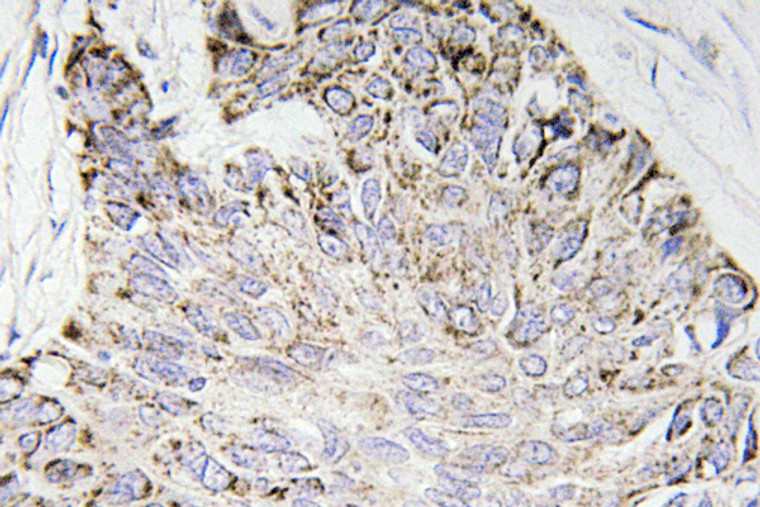| Host: |
Rabbit |
| Applications: |
WB/IHC/IF/ELISA |
| Reactivity: |
Human |
| Note: |
STRICTLY FOR FURTHER SCIENTIFIC RESEARCH USE ONLY (RUO). MUST NOT TO BE USED IN DIAGNOSTIC OR THERAPEUTIC APPLICATIONS. |
| Short Description: |
Rabbit polyclonal antibody anti-Caspase-4-II (75-124 aa) is suitable for use in Western Blot, Immunohistochemistry, Immunofluorescence and ELISA research applications. |
| Clonality: |
Polyclonal |
| Conjugation: |
Unconjugated |
| Isotype: |
IgG |
| Formulation: |
Liquid in PBS containing 50% Glycerol, 0.5% BSA and 0.02% Sodium Azide. |
| Purification: |
The antibody was affinity-purified from rabbit antiserum by affinity-chromatography using epitope-specific immunogen. |
| Concentration: |
1 mg/mL |
| Dilution Range: |
WB 1:500-1:2000IHC 1:100-1:300ELISA 1:40000IF 1:50-200 |
| Storage Instruction: |
Store at-20°C for up to 1 year from the date of receipt, and avoid repeat freeze-thaw cycles. |
| Gene Symbol: |
CASP4 |
| Gene ID: |
837 |
| Uniprot ID: |
CASP4_HUMAN |
| Immunogen Region: |
75-124 aa |
| Specificity: |
Caspase-4 Polyclonal Antibody detects endogenous levels of Caspase-4 protein. |
| Immunogen: |
The antiserum was produced against synthesized peptide derived from the human Caspase-4 at the amino acid range 75-124 |
| Post Translational Modifications | In response to activation signals, including endoplasmic reticulum stress or treatment with amyloid-beta A4 protein fragments (such as amyloid-beta protein 40), undergoes autoproteolytic cleavage. (Microbial infection) ADP-riboxanation by S.flexneri OspC3 blocks CASP4 autoprocessing, preventing CASP4 activation and ability to recognize and cleave GSDMD, thereby thwarting the inflammasome/pyroptosis-mediated defense. |
| Function | Inflammatory caspase that acts as the effector of the non-canonical inflammasome by mediating lipopolysaccharide (LPS)-induced pyroptosis. Also indirectly activates the NLRP3 and NLRP6 inflammasomes. Acts as a thiol protease that cleaves a tetrapeptide after an Asp residue at position P1: catalyzes cleavage of CGAS, GSDMD and IL18. Effector of the non-canonical inflammasome independently of NLRP3 inflammasome and CASP1: the non-canonical inflammasome promotes pyroptosis through GSDMD cleavage without involving secretion of cytokine IL1B and IL18. In the non-canonical inflammasome, CASP4 is activated by direct binding to LPS without the need of an upstream sensor. LPS-binding promotes CASP4 activation and CASP4-mediated cleavage of GSDMD, followed by pyroptosis of infected cells and their extrusion into the gut lumen. Also indirectly promotes secretion of mature cytokines (IL1A, IL18 and HMGB1) downstream of GSDMD-mediated pyroptosis via activation of the NLRP3 and NLRP6 inflammasomes. Involved in NLRP3-dependent CASP1 activation and IL1B and IL18 secretion in response to non-canonical activators, such as UVB radiation or cholera enterotoxin. Involved in NLRP6 inflammasome-dependent activation in response to lipoteichoic acid (LTA), a cell-wall component of Gram-positive bacteria, which leads to CASP1 activation and IL1B and IL18 secretion. Involved in LPS-induced IL6 secretion.this activity may not require caspase enzymatic activity. The non-canonical inflammasome is required for innate immunity to cytosolic, but not vacuolar, bacteria. Plays a crucial role in the restriction of S.typhimurium replication in colonic epithelial cells during infection. Pyroptosis limits bacterial replication, while cytokine secretion promotes the recruitment and activation of immune cells and triggers mucosal inflammation. May also act as an activator of adaptive immunity in dendritic cells, following activation by oxidized phospholipid 1-palmitoyl-2-arachidonoyl- sn-glycero-3-phosphorylcholine, an oxidized phospholipid (oxPAPC). Involved in cell death induced by endoplasmic reticulum stress and by treatment with cytotoxic APP peptides found in Alzheimer's patient brains. Cleavage of GSDMD is not strictly dependent on the consensus cleavage site but depends on an exosite interface on CASP4 that recognizes and binds the Gasdermin-D, C-terminal (GSDMD-CT) part. Catalyzes cleavage and maturation of IL18. In contrast, it does not directly process IL1B. During non-canonical inflammasome activation, cuts CGAS and may play a role in the regulation of antiviral innate immune activation. (Microbial infection) In response to the Td92 surface protein of the periodontal pathogen T.denticola, activated by cathepsin CTSG which leads to production and secretion of IL1A and pyroptosis of gingival fibroblasts. |
| Protein Name | Caspase-4Casp-4Ice And Ced-3 Homolog 2Ich-2Ice(Rel-IiMih1Protease Tx Cleaved Into - Caspase-4 Subunit P10 - Caspase-4 Subunit P20 |
| Database Links | Reactome: R-HSA-168638Reactome: R-HSA-5620971 |
| Cellular Localisation | CytoplasmCytosolEndoplasmic Reticulum MembranePeripheral Membrane ProteinCytoplasmic SideMitochondrionInflammasomeSecretedPredominantly Localizes To The Endoplasmic Reticulum (Er)Association With The Er Membrane Requires Tmem214Released In The Extracellular Milieu By Keratinocytes Following Uvb Irradiation |
| Alternative Antibody Names | Anti-Caspase-4 antibodyAnti-Casp-4 antibodyAnti-Ice And Ced-3 Homolog 2 antibodyAnti-Ich-2 antibodyAnti-Ice(Rel-Ii antibodyAnti-Mih1 antibodyAnti-Protease Tx Cleaved Into - Caspase-4 Subunit P10 - Caspase-4 Subunit P20 antibodyAnti-CASP4 antibodyAnti-ICH2 antibody |
Information sourced from Uniprot.org
12 months for antibodies. 6 months for ELISA Kits. Please see website T&Cs for further guidance








